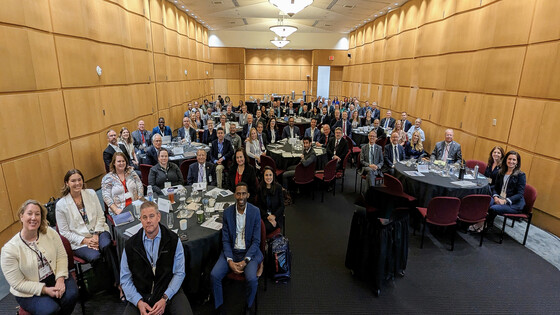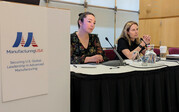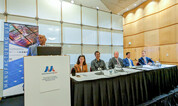
Thanks to all who could attend the 2023 Manufacturing USA Network Meeting! We had over 100 participants attend nine unique sessions with keynotes from White House leadership.
We appreciated the opportunity to listen and learn from the network about how we can collectively support and scale advanced manufacturing. We hope you found value in the information sharing on select topics.
Please provide feedback through our survey about the event or a particular session so our meeting next year can better serve the network needs.
Session summaries are provided below and copies of the slides are provided here. We have included emails and are happy to connect you to the chairs who led the discussion.

Opening Keynote: Justina Gallegos, Deputy Director for Industrial Innovation at the Office of Science and Technology Policy and Dr. Monica Gorman, Special Assistant to the President for Manufacturing and Industrial Policy, National Economic Council
Justina Gallegos highlighted the Administration’s focus on growing the American economy from the bottom up and middle out, recent historic national investments, and the importance of collaboration across the U.S. government. She touched on recommendations from the first White House Manufacturing USA Summit in October. In addition, she emphasized Manufacturing USA’s efforts to create place-based industrial ecosystems, advance public-private partnerships, and catalyze private investment to match public resources as important for implementing the industrial strategy. Justina shared her new Industrial Innovation Team’s vision for pilot facilities to help build a skilled workforce and transition from traditional to advanced manufacturing.
Dr. Monica Gorman provided an overview of the Modern American Industrial Strategy and the importance of bi-partisan legislation like the Bipartisan Infrastructure Law, Inflation Reduction Act, and the CHIPS & Science Act. Dr. Gorman also discussed the outcomes from the Manufacturing USA Summit, the four goals of the three-year Manufacturing USA Strategic Plan, the importance of a cohesive Manufacturing USA network for the next 10 years to ensure public investments are multiplied, and the integral role that the network can serve for the nation.
Both speakers engaged in Q+A discussions, including investment-matching to deliver small businesses the resources needed to build a strong workforce, access to funding required for scale-up, the importance of the strategic plan in achieving interagency coordination, measuring and communicating impact, cybersecurity and other strategies to strengthen SMMs and the domestic supply chain, and how the institutes can get engaged in the Advanced Manufacturing Sprint and Workforce Hubs. The speakers closed by thanking everyone for their partnership, emphasizing that they are champions for the work the Manufacturing USA network is doing and that they are available and excited to continue working together.
|

Manufacturing USA: 10 Year Vision: Don Ufford (NIST)
Institute and agency staff participated in an interactive session moderated by Don Ufford to share thoughts on the vision for the Manufacturing USA Network of the Future. Through crowd-sourced answers to six questions from 12 discussion teams situated throughout the room, the participants generated ideas on enhancing the network function, optimizing funding, expanding workforce development, and delivering technology. The ideas will be shared with participants for use by teams as near and long-term institute and network strategies are developed.
|

Federal Funding Showcase: Nancy Gilbert (EDA), Thyagarajan Nandagopal (NSF), John Vickers (NASA), Zack Valdez (DOE MESC), and Michael Taylor (NIST MEP)
Panelists representing 5 different agencies presented an overview of their structure and priorities, current opportunities relevant to Manufacturing USA, and information about upcoming opportunities that institutes can look for over the next 4-12 months. Each agency presented a 5-minute showcase of these funding opportunities and the slides shared (and now accessible via the link in this email) capture where to find details on relevant information on how to apply.
|
 |
|
CHIPS and Science Act – Manufacturing USA Opportunities: Dr. Eric Lin, CHIPS R&D Acting Director
Dr. Eric Lin provide information and updates from the CHIPS Program Office. This included a summary of the Manufacturing USA RFI input from the institutes and ways in which the institutes can connect with the broader CHIPS for America portfolio.
|
Manufacturing USA WEAVE Funding Opportunity + Beyond: Dr. Kelley Rogers, Acting Chief of the Program Operations Division, Office of Advanced Manufacturing (NIST)
Kelley gave a high-level overview of an upcoming (anticipated) Manufacturing USA Workforce, Education and Vibrant Ecosystems (WEAVE) funding opportunity. WEAVE awards are anticipated to fund high-impact projects within the Manufacturing USA network to support vibrant and inclusive advanced manufacturing ecosystems and expand successful institute-sponsored workforce development programs to promote domestic production of institute-developed technologies. Open only to Manufacturing USA institutes, all will be eligible to propose projects. Project proposals must be a partnership between two or more institutes. It is anticipated that the formal announcement of this funding opportunity will be posted within two weeks and an informational webinar will be held shortly after the posting. Notification of the actual funding opportunity, slides and webinar recording of will be shared with the attendees. Following the presentation, attendees were given the opportunity to ask questions related to the anticipated funding opportunity and identified education and workforce development as a key area for future resources that are of national interest and unlikely to be funded by the private sector.
National Workforce Strategy: Dr. Sue Helper (OMB), Brittany Stich (DOL), Piper O'Keefe (DOE), and Luke Rhine (DoEd)
This session included perspectives from the Administration on the importance of sector partnerships between all stakeholders in the workforce system and the inclusion of Manufacturing USA institutes to act as force multipliers. Institutes can leverage in-place training providers and student recruitment efforts for greater integration between training and technology sector needs and consider how best to integrate technology into job design and training. Several new announcements and funding opportunities were presented, including the new Advanced Manufacturing Sprint and Workforce Hubs in five cities (Phoenix, Baltimore, Augusta, Pittsburgh, and Columbus) which specifically call out the Manufacturing USA institutes and was announced on May 16 by the First Lady. Other funding opportunities were shared from DOL (link here) and DoEd (link here). In addition, the Battery Workforce Initiative was shared as an example of broad industry partnership supporting increased domestic skills needed for battery manufacturing. The Q+A portion highlighted the Manufacturing USA network’s strong interest in the Advanced Manufacturing Sprint, desire for a coordinated national advanced manufacturing workforce campaign, and eagerness to participate in conversations and events as part of the workforce hub efforts.
Manufacturing Technology Scale-up & Deployment: Jennifer MacDonald, MD, Chief Operating Officer at BioFabUSA
Jennifer MacDonald moderated a discussion among leaders from the Manufacturing USA institutes who shared their institutes’ experiences with transitioning technology into production and the different approaches that could be used based on the organizational needs. Examples that spanned 10 different technology areas and included start-ups, medium and large corporations were shared by: Dr. Wade Cook, Executive Director, AIM Photonics; Victor Veliadis, Executive Director, PowerAmerica; Nicole Merli, Business Development Manager, NIIMBL; John Wilczynski, CEO, America Makes; Ira Moskowitz, CEO, ARM; Chad Duty, CEO, IACMI; Ed Daniels, Director of Strategic Programs, REMADE; Melanie M. Tomczak, CTO, BioMADE; Berardino Baratta, CEO, MxD; Jennifer MacDonald, COO, BioFabUSA.
Director's Dialogue: Mike Molnar (NIST), Tracy Frost (DoD), Diana Bauer (DOE), and Mark Gordon (DoD)
Mark Gordon facilitated a discussion with Mike Molnar, Tracy Frost, Diana Bauer and institute directors on network coordination mechanisms, successes, and opportunities. Mechanisms include: the interagency Advanced Manufacturing National Program Office (AMNPO) hosted by NIST to support the Manufacturing USA network; an independent Institute Directors Council; Office Directors meetings; federal Interagency Working Team meetings; cross-institute and agency teams such as Communications and Education and Workforce Development (the latter met the day prior at Nexight in Silver Spring, MD); the National Science and Technology Council Subcommittee on Advanced Manufacturing; and the new Manufacturing USA Council (successfully formed earlier in the day with an approved Council Charter and Council Chair, Ignasi Palou-Rivera from the RAPID institute. Examples of successful collaboration initiatives were shared. Suggestions on coordination activities that could forge more meaningful collaboration across institutes included more exposure to other federal agencies, multi-institute membership agreements, strategic engagement of states and SMMs, having a dedicated contact at each agency for institutes to make connections outside of their sponsored agency, and more networking events.
Closing Remarks:
Agency leaders thanked everyone for attending, speaking, facilitating, or chairing a session, and for the planning team’s work preparing the meeting. There was palpable knowledge and energy in the room, which is crucial for what the nation needs in advanced manufacturing. The network does good work and has an opportunity to secure impact in the space we can occupy and not try to be everything to everybody. It’s becoming even more evident just how central people are to the future.
|